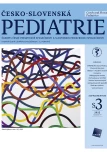Endocrine causes of obesity in childhood and adolescence
Authors:
Pomahačová Renata; Paterová Petra; Nykodýmová Eva; Sládková Eva; Skalická Eva; Sýkora Josef
Authors‘ workplace:
Univerzita Karlova v Praze
; Dětská klinika, Lékařská fakulta, a Fakultní nemocnice v Plzni
Published in:
Čes-slov Pediat 2022; 77 (Supplementum 3): 24-29.
Category:
Comprehensive Report
doi:
https://doi.org/10.55095/CSPediatrie2022/055
Overview
The most common type of childhood obesity is simple obesity which develops as a result of a combination of certain genetic and environmental factors. Secondary obesity is caused by rare genetic forms of obesity, by certain drugs and by the following endocrine diseases: hypothyroidism, Cushing’s syndrome, growth hormone deficiency, hypogonadism, pseudohypoparathyroidism type Ia, insulinoma, hypothalamic obesity and polycystic ovary syndrome. Early detection of the endocrine cause of obesity leads to a reduction in morbidity and, in some cases, mortality in these children. Doctors must diagnose secondary obesity, distinguish it from simple obesity, and treat it accordingly. When examining causes of obesity, not only personal medical history, but also the family medical history is necessary; clinical examination and the evaluation of the child’s growth curve and BMI (body mass index) are crucial. This text describes pathophysiological mechanisms resulting in endocrinopathy-related obesity, as well as typical clinical and laboratory findings, pathological growth and BMI curves confirming a specific endocrinopathy.
Keywords:
insulinoma – Polycystic ovary syndrome – Hypothyroidism – Cushing’s syndrome – hypogonadism – secondary obesity – growth hormone deficiency – pseudohypoparathyroidism type Ia – hypothalamic obesity
Sources
- Lebl J, Al Taji E, Koloušková S, et al. Dětská endokrinologie a diabetologie. 1. vyd. Praha: Galén 2016.
- Stipančić G, Požgaj Šepec M. Secondary causes of obesity in children and adolescents. Central Eur J Paed 2018; 14(1): 1–11.
- Styne DM, Arslanian SA, Connor EL, et al. Pediatric obesity-assessment, treatment, and prevention: an Endocrine Society Clinical practice guideline. J Clin Endocrinol Metab 2017; 102(3): 709–757.
- Karam JG, McFarlane SI. Secondary causes of obesity. Therapy 2007; 4(5): 641–650.
- Crocker MK, Yanovski JA. Pediatric obesity: etiology and treatment. Pediatr Clin North Am 2011; 58(5): 1217–41.
- Mason K, Page L, Balikcioglu PG. Screening for hormonal, monogenic, and syndromic disorders in obese infants and children. Pediatr Ann 2014; 43(9): e218–e224.
- Pomahačová R., Kalvachová B. Dětská endokrinologie do kapsy. 3. vyd. Praha: Maxdorf 2021.
- Stratakis CA. An update on Cushing syndrome in pediatrics. Ann Endocrinol (Paris) 2018; 79(3): 125–131.
- Storr HL, Alexandraki KI, Martin L, et al. Comparisons in the epidemiology, diagnostic features and cure rate by transsphenoidal surgery between paediatric and adult-onset Cushing’s disease. Eur J Endocrinol 2011; 164(5): 667–74.
- Savage MO, Storr HL, Chan LF, et al. Diagnosis and treatment of pediatric Cushing’s disease. Pituitary 2007; 10(4): 365–71.
- Savage MO, Storr HL. Pediatric Cushing’s disease: Management Issues. Indian J Endocrinol Metab 2012; 16(2): 171–5.
- Oliveira EM, Keogh JM, Talbot F, et al. Obesity-associated GNAS mutations and the melanocortin pathway. N Engl J Med 2021; 385(17): 1581– 1592.
- Bereket A, Kiess W, Lustig RH, et al. Hypotalamic obesity in children. Obes Rev 2012; 13(9): 780–98.
- Műller HL, Bueb K, Bartels U, et al. Obesity after childhood craniopharyngioma: German multicenter study on preoperative risk factors and quality of life. Klin Padiatr 2001; 213(4): 244–9.
- Pomahačová R. Cushingův syndrom v dětském věku. Čes-slov Pediat 2015; 70(3): 190–192.
Labels
Neonatology Paediatrics General practitioner for children and adolescentsArticle was published in
Czech-Slovak Pediatrics

2022 Issue Supplementum 3
Most read in this issue
- Minipuberty – an important and still neglected period of sexual development
- First experience with long-acting growth hormone
- Current perspectives on the aetiology of tall stature in children and adolescents (1): Syndromes associated with tall stature
- Children and adolescents with gender incongruence: current approaches and situation in the Czech Republic
